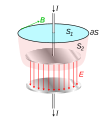Fișier:Displacement current in capacitor.svg

Mărimea acestei previzualizări PNG a acestui fișier SVG: 558 × 600 pixeli. Alte rezoluții: 223 × 240 pixeli | 446 × 480 pixeli | 714 × 768 pixeli | 952 × 1.024 pixeli | 1.905 × 2.048 pixeli | 744 × 800 pixeli.
Mărește rezoluția imaginii (Fișier SVG, cu dimensiunea nominală de 744 × 800 pixeli, mărime fișier: 57 KB)
Istoricul fișierului
Apăsați pe Data și ora pentru a vedea versiunea trimisă atunci.
| Data și ora | Miniatură | Dimensiuni | Utilizator | Comentariu | |
|---|---|---|---|---|---|
| actuală | 20 noiembrie 2008 17:28 |  | 744x800 (57 KB) | Chetvorno | == Summary == {{Information |Description={{en|Diagram of a widely used example demonstrating need for the displacement current term in Maxwell's equations.}} The diagram shows a [[Wikip |
| 11 noiembrie 2008 07:56 |  | 744x800 (58 KB) | Chetvorno | {{Information |Description=Diagram demonstrating need for displacement current term in Ampere's Law. |Source=Own work by uploader |Date=2008-11-10 |Author=Chetvorno |Permission=I Chris Burks (Chetvorno) the author rel |
Utilizarea fișierului
Următoarele pagini conțin această imagine:
Utilizarea globală a fișierului
Următoarele alte proiecte wiki folosesc acest fișier:
- Utilizare la ba.wikipedia.org
- Utilizare la ce.wikipedia.org
- Utilizare la de.wikipedia.org
- Utilizare la de.wikibooks.org
- Utilizare la en.wikipedia.org
- Utilizare la en.wikiversity.org
- Utilizare la es.wikipedia.org
- Utilizare la fi.wikipedia.org
- Utilizare la he.wikipedia.org
- Utilizare la hy.wikipedia.org
- Utilizare la no.wikipedia.org
- Utilizare la ru.wikipedia.org
- Utilizare la tr.wikipedia.org










